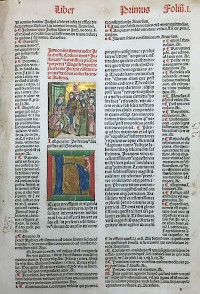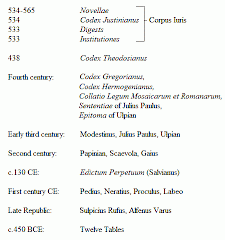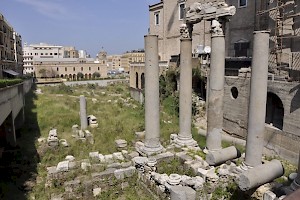Roman Law
Roman Law: the body of Roman legal sources, one of the most important set of texts from the ancient world.

The Gutenberg Bible was one of the first printed books, but it was followed soon afterward by the Corpus Iuris, the collection of Roman legal texts that had been made in 530-534 for the emperor Justinian. This Mainz edition of the Corpus Iuris, printed in 1468 by one of Gutenberg's successors, is one of the most important books in European history: for the first time, it was possible for every city, no matter how small or poor, to have access to the laws.
It seems strange that the people of the Renaissance accepted a legal system that was almost a thousand years old, but the Corpus Iuris had several advantages: it was venerably Roman and every Master of Law knew it. Another advantage was that it presented the Emperor as the source of law and did not recognize other authorities, making this a powerful instrument in the clash between the central state and feudal or religious potentates.
To function properly, the collection was considered to be a single system, as Justinian had indeed wanted it to be. It is a testimony to his legal team that it is indeed possible to regard it as one reasonably well-arranged structure, because Roman law was created out of several very diverse sources.
Foundations

A legal system is, essentially, an agreement as to how certain things can be done properly. These rules can be found in several sources. Codified laws, like Rome's fifth-century BCE Twelve Tables, are only one part of the system. After codification, modification is often necessary, and indeed, the Twelve Tables were soon revised (the Laws of Valerius and Horatius). They were proposed in the Comitia Centuriata and when they were accepted by the people, these were valid laws, leges.
Another way to establish what was proper behavior was the edictum of the praetor. In Rome, there were two praetors who were responsible for jurisdiction: the praetor urbanus for disputes between Romans, and the praetor peregrinus for disputes involving foreigners (peregrines). At the beginning of his year in office, the praetor officially announced in which cases he would grant a remedy. Of course, he did not write a full legal code, but reiterated and adapted what his predecessors had written. Roman provincial governors did the same: when they entered their provinces, they published an edict with the rules they wanted to maintain.
Officially, the Senate could only offer advice to the magistrates, who had the right to ignore it. A couple of instances are recorded: it is sufficient to know that a magistrate who did so would rarely receive the support of his fellow-senators and had essentially destroyed his own career. Senatus consulta, the “advice of the Senate”, increasingly became a kind of law. When the emperor Tiberius (r.14-37) put an end to the Comitia Centuriata, he transferred its legislative powers to the Senate, which essentially meant that from now on, senatus consulta really were laws.
To sum up, there were three sources of Roman law under the Republic.
- laws by the people’s assembly,
- edicts by the magistrates,
- senatorial advice.
It is a bit confusing and we know that the college of Roman priests that were called pontifices often had to explain things to magistrates, who had been elected for one year only and were not always very knowledgeable. This became important task after the Romans had conquered Greece and new ideas about “natural law” came to play a role. From the second century BCE, we see the rise of a professional class of secular iuris prudentes, “legal experts”, who offered responsa, “answers” to the questions of the magistrates.
Imperial Practice
The Roman emperor, who was technically the governor of some twenty provinces, ruled through edicts. It was a powerful instrument, and the distinction between the emperor’s and the Senate’s provinces was soon obsolete. Because the need for a permanent code was felt, the emperor Hadrian (r.117-138) decreed the Edictum perpetuum, an “edict for eternity”. From then on, the praetors could no longer adapt the law to changing circumstances: the imperial chancery took over this role.
By then, there was no people’s assembly to make laws, while senatusconsulta were rare. The emperor remained as the main source of law – or edicts, although they are usually called constitutiones. At the same time, the ruler was expected to answer questions, and these answers are not called responsae but rescriptae. We are fortunate that a collection survives in the tenth book of letters by Pliny the Younger, a Roman governor who asked guidance from the emperor Trajan (r.98-117). The most famous example is Trajan’s response about the Christians: they needed to be persecuted but anonymously posted accusations were a dangerous precedent. Other rescripts can be found in Justinian’s Code (below).

When writing his rescripts, the emperor could rely upon the procurator a libellis, his “minister of petitions”, who read the requests first and invited iuris prudentes to discuss them. Some of Rome’s most famous jurists, like Papinian, held this office. Other courtiers had similar tasks. We know that Pliny was over the moon when Trajan’s right-hand man Licinius Sura asked him to attend a meeting to discuss several topics on which Pliny was considered an expert.note
Creating Order
By the mid-second century, only two legal subsystems remained: building on the foundations of laws, edicts, senatorial advice, and imperial constitutions, only the emperor could add new laws and write rescripts, while the iuris prudentes continued to offer advice. Dissensions among the experts were not unusual:
If everybody expresses the same opinion, it has the force of law. If they disagree, however, the judge can decide which opinion he follows, as explained in a rescript by the emperor Hadrian.note
This was a quotation from the Institutiones by a lawyer named Gaius, who lived in the second half of the second century. This is a handbook for Roman law, which is still useful to help us understand the system – precisely because it was meant to create system. Also, unlike the legal texts contained in the Corpus Iuris Civilis of Justinian, Gaius’s Institutes have not been adapted to a sixth-century East Roman environment (“interpolated”).
Other examples of legal literature have the same ambition: the iuris prudentes were writing monographs on particular subjects and commentaries, bringing together information from various sources, and offering their own opinion where necessary. An example is the Lex Papia et Poppaea, a law that introduced privileges for people who had more than three or four children. Writing in the early third century, Julius Paulus offers advice about triplets, miscarriages, deceased children, and children born out of wedlock.note
Most of the handbooks, monographs, and commentaries are now lost, but from what remains, we can see that the subject matter was arranged quite loosely: the author mentioned a case with an interesting question, offered an opinion, and moved on to the next case. This casuistry does not make it easy to find what you need, but the Romans recognized the need to organize it better and started to write definitiones, differentiae, and regulae: various types of basic principles and abstract rules, which could be illustrated with well-known cases.
Fourth Century

The fourth century witnessed a kind of renaissance: ancient texts were copied and studied again. What applies to poets like Juvenal and Martial also applies to the legal texts: they were republished, rephrased, and updated. The texts were also summarized and some of these compendia survive, like a collection of Sententiae by Julius Paulus of Emesa and the Epitoma with the opinions of Ulpian of Tyre, who had been an adviser of the emperors Caracalla (r.211-217) and Severus Alexander (r.222-235). These fourth-century summaries may have been used as textbooks, for example in the famous school of law in Beirut.
Another new genre was the compilation. A very important example is the Collatio Legum Mosaicarum et Romanarum, which contrasts the legal system of the Romans with the laws of Moses – an obvious comparison to make in the fourth century. In this age, we also see the first codices: private collections of various legal texts without official status, documenting the rules in a given province.
All in all, the situation was becoming increasingly chaotic, even though specialists had been trying to create some order. The teachers of the Beirut law school seem to have taken the lead in a grand project of creating order: Cyrillus, head of the school, wrote the first systematic explanation of all legal definitions, and his successors were advisers to the emperor in Constantinople. The emperor Theodosius II (r. 408-450) understood their concern and ordered a codex of all imperial legislation since the reign of Constantine. This Codex Theodosianus was published in 438. It was highly influential and after the collapse of Roman administration in the west, special editions were made for the successor states in Gaul (Breviarium Alaricianum and Lex Romana Burgundionum), Spain (Lex Romana Wisigothorum and Forum Iudicum), and Italy (Edictum Theodorici).
Justinian’s Achievement

Roman law will forever be associated with the reign of Justinian, who became emperor in 527 and almost immediately ordered the codification of the full legal system. It is called the Corpus Iuris and is the culmination of a legal tradition of a millennium, which had started with the Laws of the Twelve Tables.
In 528, he appointed a committee of ten specialists who had to create a new codex of imperial legislation and could add what was necessary, leave out what was redundant, and change what was impractical. The job was done in about a year. One fragment of this Codex Justinianus survives.
The responses of the iuris prudentes were the next project: the team, now under the direction of Tribonianus, had to select everything that was useful in the second- and third-century handbooks, monographs, and commentaries, and the more recent compendia. Repetitions and contradictions had to be avoided, necessary changes (“interpolations”) had to be made, and everything that was incomplete, unnecessary, or outdated had to be erased.
The Digestae, assembled in 530-533, are a splendid text. In fifty books, subdivided in titles, chapters, and sections, every subject is dealt with. Because Justinian had explicitly demanded it so, the names of the original iuris prudentes had to be recorded out of respect for the past. If a modern reference is to “Ulp., D. 50.15.1. pr.”, this means that a section by Ulpian is meant, which can be found in the fiftieth book of the Digests, title fifteen, chapter one, in the prologue. In this section, we read that several cities in Syria combined the rank of colonia with Italian rights, and that Ulpian’s hometown Tyre was one of these, because it was “the most noble city of all”, very ancient, warlike, “most constant in its observance of treaties”, and very loyal to Rome. The fact that these words are retained suggests that the team that compiled the Digestae did not leave out everything that was unnecessary.
Justinian also ordered a new handbook, the Institutiones, which was based on the handbook by Gaius (quoted above). It was completed at the same time as the Digestae. These two new books made a revision of the Codex Justinianus necessary, and this was published in 534. During the next thirty years, Justinian continued to add new laws, in Greek, which are called the Novellae.
Together, these four texts – Institutiones, Codex, Digestae, Novellae – are known as the Corpus Iuris. To a historian, it is a veritable goldmine. Here we have a large body of Roman legislation, relevant to Late Antiquity, but based on older regulations, which we can try to reconstruct. This is very valuable information.
Besides, the casuistry of the Digestae offers unexpected views on lawsuits that demanded advice, allowing us to learn a lot about the things that really mattered to the Romans. And occasionally, you can suddenly recognize the personality of a legal expert. It tells a lot about Julius Paulus’ sense of humor that, commenting on the law that adulterers ought to lose their property and be exiled to an island, he advised exile on separate islands.note
The Digestae as Source
One of the big questions is how the Digestae could have been compiled in such a short time: three years. It is usually assumed that there was an older collection, available at the Beirut school of law. If this is true, the historian who wants to use information from the Digestae must be cautious. The original texts were written in Italy, the first collection was relevant for Syria, while Justinian aimed at reintroducing this as a new standard for the Byzantine Empire. Whether the casuistry of the Digestae was relevant to Hispania, Gaul, Britain, or the Rhine-Danube frontier, remains to be seen.